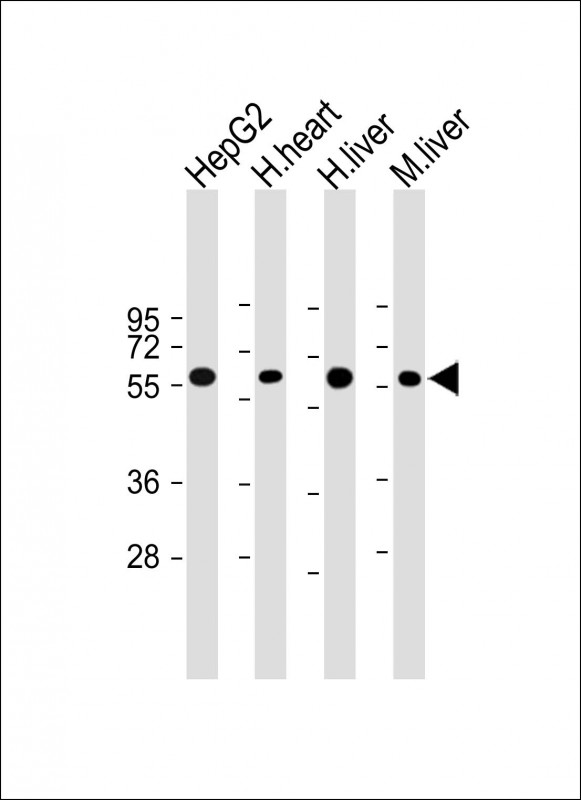
Mouse Anti-CRY2 antibody
CRY2_HUMAN; cryptochrome 2 (photolyase like); Cryptochrome2; Cryptochrome 2; Cryptochrome-2; FLJ10332; growth inhibiting protein 37; HCRY2; KIAA0658; PHLL2; Photolyase like.
View History [Clear]
Details
Product Name CRY2 Chinese Name 隐色素-2单克隆抗体 Alias CRY2_HUMAN; cryptochrome 2 (photolyase like); Cryptochrome2; Cryptochrome 2; Cryptochrome-2; FLJ10332; growth inhibiting protein 37; HCRY2; KIAA0658; PHLL2; Photolyase like. Research Area Cell biology Neurobiology Immunogen Species Mouse Clonality Monoclonal Clone NO. Q3W3 React Species Human, Mouse, Applications WB=1:500-2000
not yet tested in other applications.
optimal dilutions/concentrations should be determined by the end user.Theoretical molecular weight 65kDa Cellular localization The nucleus cytoplasmic Form Liquid Concentration 1mg/ml immunogen Recombinant human Cry2. Lsotype IgG1,k Purification affinity purified by Protein G Buffer Solution 0.01M TBS(pH7.4) with 1% BSA, 0.03% Proclin300 and 50% Glycerol. Storage Shipped at 4℃. Store at -20 °C for one year. Avoid repeated freeze/thaw cycles. Attention This product as supplied is intended for research use only, not for use in human, therapeutic or diagnostic applications. PubMed PubMed Product Detail This gene encodes a flavin adenine dinucleotide-binding protein that is a key component of the circadian core oscillator complex, which regulates the circadian clock. This gene is upregulated by CLOCK/ARNTL heterodimers but then represses this upregulation in a feedback loop using PER/CRY heterodimers to interact with CLOCK/ARNTL. Polymorphisms in this gene have been associated with altered sleep patterns. The encoded protein is widely conserved across plants and animals. Two transcript variants encoding different isoforms have been found for this gene. [provided by RefSeq, Feb 2014]
Function:
Lamins are components of the nuclear lamina, a fibrous layer on the nucleoplasmic side of the inner nuclear membrane, which is thought to provide a framework for the nuclear envelope and may also interact with chromatin. Lamin A and C are present in equal amounts in the lamina of mammals. Play an important role in nuclear assembly, chromatin organization, nuclear membrane and telomere dynamics.
Prelamin-A/C can accelerate smooth muscle cell senescence. It acts to disrupt mitosis and induce DNA damage in vascular smooth muscle cells (VSMCs), leading to mitotic failure, genomic instability, and premature senescence.
Subunit:
Component of the circadian core oscillator, which includes the CRY proteins, CLOCK or NPAS2, ARNTL or ARNTL2, CSNK1D and/or CSNK1E, TIMELESS, and the PER proteins. Interacts directly with PER1 and PER2 C-terminal domains. Interaction with PER2 inhibits its ubiquitination and vice versa. Interacts with NFIL3. Interacts with FBXL3.
Subcellular Location:
Cytoplasm. Nucleus. Translocated to the nucleus through interaction with other Clock proteins such as PER2 or ARNTL.
Tissue Specificity:
Expressed in all tissues examined including fetal brain, fibroblasts, heart, brain, placenta, lung, liver, skeletal muscle, kidney, pancreas, spleen, thymus, prostate, testis, ovary, small intestine, colon and leukocytes. Highest levels in heart and skeletal muscle.
Post-translational modifications:
Phosphorylation on Ser-266 by MAPK is important for the inhibition of CLOCK-ARNTL-mediated transcriptional activity. Phosphorylation by CSKNE requires interaction with PER1 or PER2.
Ubiquitinated by the SCF(FBXL3) and SCF(FBXL21) complex, leading to its degradation.
DISEASE:
Belongs to the DNA photolyase class-1 family.
Contains 1 DNA photolyase domain.
Similarity:
Belongs to the intermediate filament family.
SWISS:
Q49AN0
Gene ID:
1408
Database links:Entrez Gene: 1408 Human
Entrez Gene: 12953 Mouse
SwissProt: Q49AN0 Human
SwissProt: Q9R194 Mouse
Product Picture
Lane 1: HepG2 cell lysates
Lane 3: Human heart tissue lysates
Lane 3: Human liver tissue lysates
Lane 4: Mouse liver tissue lysates
Primary: Anti-CRY2 (SLM-51684M) at 1/4000 dilution
Secondary: IRDye800CW Goat Anti-Mouse IgG at 1/20000 dilution
Predicted band size: 65 kD
Observed band size: 60 kD
Bought notes(bought amounts latest0)
No one bought this product
User Comment(Total0User Comment Num)
- No comment



 +86 571 56623320
+86 571 56623320




